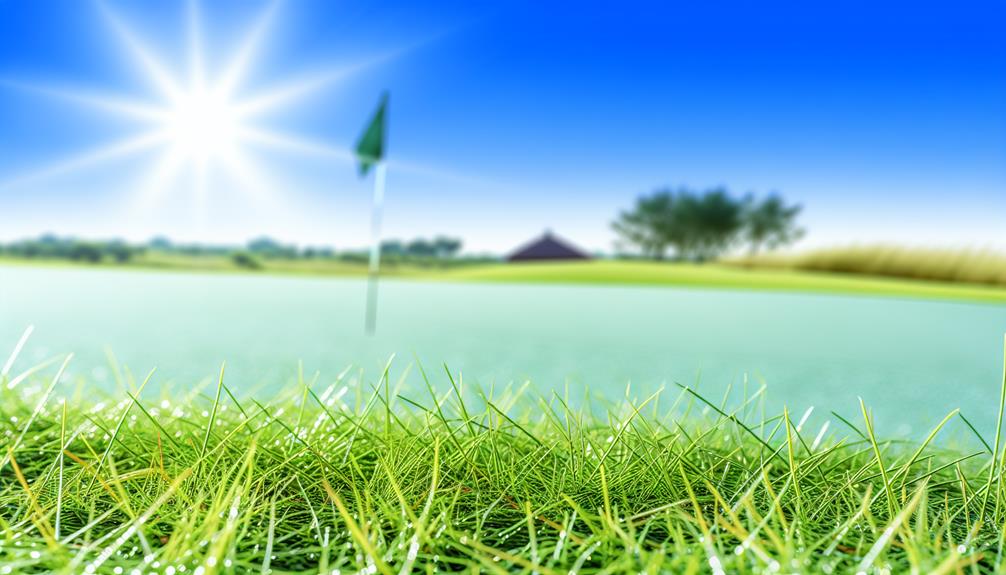As the old adage goes, 'The grass is always greener on the other side.' But when it comes to golf putting greens, you can't simply settle for what's on the other side. You've got to make an informed choice, considering factors like durability, maintenance, aesthetics, and of course, the playability it offers.
However, with a plethora of grass types available, from Bentgrass to Bermuda, Creeping Bentgrass to Velvet Bentgrass, and even Poa Annua, the decision can be quite complex. When several of these options seem to tick all the boxes, how do you determine which one is the most suitable for your golf course?
Let's delve into the specifics so we can figure this out.
Understanding Golf Putting Green Requirements
What factors should you consider when designing a golf putting green? The answer isn't as straightforward as it might seem. It's not just about the aesthetics; you also need to consider the green maintenance and the soil composition.
Green maintenance is a crucial aspect that can't be overlooked. A well-maintained green ensures a smooth playing surface, enhancing the golfer's experience. This involves meticulous mowing, watering, and aeration to keep the grass healthy and at the optimal height. It's a labor-intensive process that requires both time and knowledge, so don't underestimate its importance.
Soil composition is another key factor. The type of soil determines the grass's growth and overall quality. Sandy soils, for instance, are often preferred because they offer good drainage, which is essential for preventing water logging and promoting healthy root growth. But, it's not just about the soil type. You also need to consider the soil's pH level, nutrient content, and compaction level. All these factors influence how well the grass will grow and thrive.
Benefits of Bentgrass for Greens
Having considered the importance of maintenance and soil composition in golf putting green design, let's now explore why Bentgrass is often the grass of choice for these greens.
Bentgrass offers numerous advantages, chief among them is its relatively easy maintenance. Bentgrass maintenance largely involves regular mowing and watering, making it a cost-effective choice for many golf course owners. Its ability to withstand heavy foot traffic also contributes to its popularity.
Another key attribute of Bentgrass is its disease resistance. This means that it's less likely to succumb to common turf diseases. This resilience results in reduced expenses related to disease control and management, which can be a significant cost saving over time.
Also, Bentgrass provides a smooth, even surface that's ideal for putting. It has a fine texture and dense growth habit that creates a uniform playing surface, enabling golf balls to roll smoothly and predictably. So, it's not just about aesthetics or easy maintenance; choosing Bentgrass can actually enhance the gameplay on your greens.
Why Bermuda Grass Is a Top Choice
Despite the numerous benefits of Bentgrass, Bermuda grass also stands out as a top choice for golf putting greens due to its heat resistance and durability. You'll find that Bermuda grass thrives in warm climates, offering a high level of climate suitability. Its robust growth pattern allows it to recover quickly from divots and other forms of wear and tear. This resilience, paired with its ability to withstand high temperatures, makes it an ideal choice for courses located in warmer regions.
Bermuda Grass Maintenance, while crucial, isn't overly complex. Regular mowing, fertilizing, and watering help this grass maintain its lush, green appearance. This grass species has a high tolerance for drought conditions, making it less demanding in terms of watering compared to other types. Just ensure you adhere to a regular fertilizing schedule to sustain its health.
Exploring Creeping Bentgrass Varieties
While Bermuda grass offers a robust solution for warmer climates, you'll find an equally compelling alternative in the varieties of Creeping Bentgrass for cooler regions. Renowned for its smooth, carpet-like texture and superior ball roll, Creeping Bentgrass is a favorite among golf course superintendents in cooler climates.
There are several varieties of Creeping Bentgrass, each with its unique characteristics. Varieties like 'Penncross' and 'Penn A-4' are appreciated for their dense growth and excellent disease resistance. Other types, like 'L-93', offer superior drought tolerance and less frequent watering requirements.
Bentgrass maintenance is key to its performance. Regular mowing at a height of 1/8 to 1/4 inch is essential to maintain its desirable characteristics. Equally crucial is a robust watering and fertilization schedule, which helps the grass recover quickly from stress.
Temperature tolerance is another crucial aspect of Creeping Bentgrass. It thrives in cooler temperatures, typically between 60°F and 75°F. In contrast, prolonged exposure to temperatures above 85°F can lead to stress and disease. Therefore, it's critical to monitor and manage temperature conditions carefully.
Comparing Velvet Bentgrass and Poa Annua
When it comes to selecting ideal grass for golf putting greens, Velvet Bentgrass and Poa Annua are two noteworthy contenders you might consider.
Poa Annua, often regarded as a nuisance by some, is actually a viable choice with proper management. Poa Annua management emphasizes the importance of regular mowing and fertilizing to maintain its dense, uniform surface. It's adaptable, tolerating a wide range of climates, and providing a smooth putting surface. Yet, it's known for its susceptibility to diseases, which might require more care.
On the flip side, there's Velvet Bentgrass. Its cultivation requires a cooler, moist climate for optimal growth. It's known for its fine texture and high density, providing a consistent, smooth surface for putting. Velvet Bentgrass cultivation, however, involves more intricate maintenance. It demands frequent mowing and watering to prevent thatch buildup and to preserve its desirable characteristics.
In choosing between the two, consider your climate, maintenance capabilities, and desired putting green characteristics. Both Velvet Bentgrass and Poa Annua have their advantages and challenges. Your choice will ultimately depend on which grass better suits your specific needs and environment. Remember, the ideal putting green grass isn't just about looks, but also about performance.

